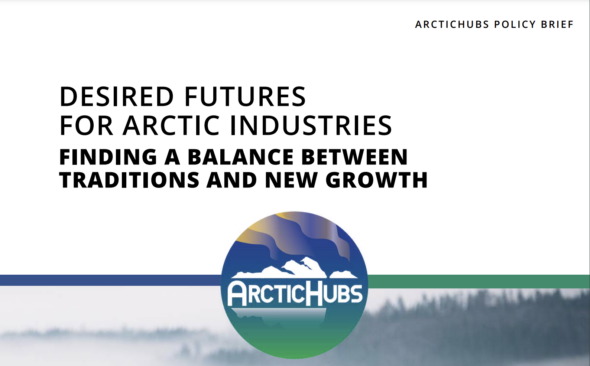How do we create a sustainable Arctic where both traditional livelihoods and new economic opportunities can coexist and thrive?
The ArcticHubs project, as part of its ongoing work, has explored this question deeply, resulting in a new policy brief that offers key insights and recommendations for Arctic stakeholders.

The policy brief, Desired Futures for Arctic Industries, is the outcome of extensive futures studies conducted in partnership with local and indigenous communities across the Arctic. The aim was to envision scenarios up to 2035, allowing stakeholders to anticipate challenges and opportunities, and to develop creative strategies for a more resilient Arctic. Here are some of the key takeaways from the policy brief that highlight what a sustainable future for Arctic industries could look like.
Finding a balance between tradition and growth
In the Arctic, new industries such as tourism, aquaculture, and mining are expanding alongside traditional livelihoods like reindeer herding and fishing. This growth creates both opportunities and challenges. The policy brief emphasizes that the most desirable future for Arctic industries is one that finds a balance between economic growth and respecting traditional ways of life. Achieving this balance requires the involvement of local communities at every stage of development, ensuring that their voices are heard and their rights respected.
Key Recommendations for Arctic Industries
- Tourism: the focus for tourism should be on quality over quantity. The policy brief suggests exploring tourism fees or taxes to better manage resources and support local communities. Transparent decision-making and inclusiveness are crucial for ensuring that tourism benefits everyone.
- Forestry: effective forest management requires collaboration among all stakeholders. The brief recommends establishing forums for ongoing dialogue between forestry stakeholders, reindeer herders, and local residents to ensure that diverse needs are respected.
- Aquaculture: the environmental impacts of aquaculture need careful attention. Strengthening regulations to minimize these impacts and exploring more sustainable production methods are vital for protecting fjord ecosystems and ensuring long-term viability.
- Mining: informal communication with local communities, in addition to formal meetings, can help build trust and acceptance. Mining companies are encouraged to invest time in community relations, particularly focusing on environmental concerns that often drive opposition.
- Reindeer herding and indigenous livelihoods: the policy brief calls for special attention to the cumulative impacts of land use on reindeer herding and other traditional livelihoods. Coordinating various activities and acknowledging the unique challenges faced by indigenous peoples are essential steps toward a sustainable future.
- The power of futures studies: one of the central ideas of the ArcticHubs project is using futures studies as a tool to open minds to new possibilities. By envisioning multiple future scenarios, stakeholders can better understand potential threats and opportunities, enabling them to act sooner and more strategically. The scenarios developed through this process were evaluated by both local actors and external experts, ensuring that the resulting recommendations are grounded in local realities and informed by broader expertise.
A path forward for all Arctic stakeholders
The ArcticHubs policy brief is a call to action for all stakeholders involved in Arctic development—from policymakers and industry leaders to local and indigenous communities.
It highlights the importance of transparent and inclusive decision-making, balancing growth with sustainability, and respecting the rights and traditions of Arctic peoples. Achieving a shared vision for the Arctic’s future requires cooperation, creativity, and a commitment to both the environment and the well-being of its people.
To learn more about the Desired Futures for Arctic Industries and how you can contribute to a sustainable Arctic, visit ArcticHubs Project Results. Together, we can shape a future where all Arctic stakeholders thrive.
